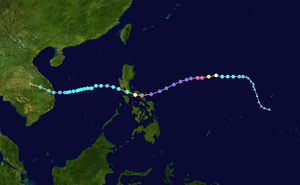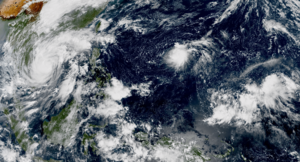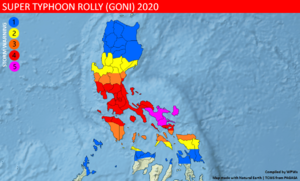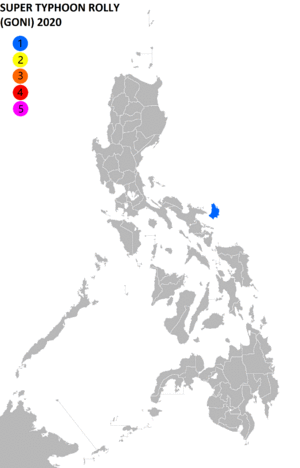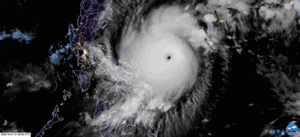Typhoon Goni facts for kids
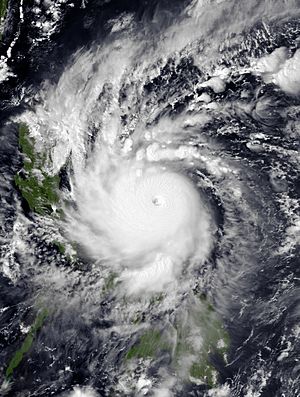
Goni at peak intensity, prior to landfall in the Philippines on October 31
|
|
| Meteorological history | |
|---|---|
| Formed | 26 October 2020 |
| Dissipated | 6 November 2020 |
| Unknown strength tropical cyclone | |
| 10-minute sustained (JMA) | |
| Highest winds | 220 km/h (140 mph) |
| Lowest pressure | 905 hPa (mbar); 26.72 inHg |
| Category 5 tropical cyclone | |
| 1-minute sustained (SSHWS/JTWC) | |
| Highest winds | 315 km/h (195 mph) |
| Lowest pressure | 884 hPa (mbar); 26.10 inHg |
| Overall effects | |
| Fatalities | 32 |
| Damage | $1.02 billion (2020 USD) |
| Areas affected | Philippines, Vietnam, Cambodia, Laos |
|
Part of the 2020 Pacific typhoon season |
|
Typhoon Goni, also known in the Philippines as Super Typhoon Rolly, was a super powerful tropical cyclone. It hit land as a Category 5 super typhoon in Catanduanes, Philippines. It also reached Vietnam as a tropical storm. Goni was the strongest tropical cyclone ever recorded to hit land, based on its 10-minute sustained winds.
It was the 19th named storm and the second super typhoon of the 2020 Pacific typhoon season. Goni started as a tropical depression near Guam on October 26, 2020. It quickly grew stronger, becoming a Category 5 super typhoon by October 30. Goni stayed super strong for over a day. It hit Catanduanes with winds of about 220 kilometers per hour (135 mph). This made it the most intense tropical cyclone seen anywhere in the world in 2020.
After hitting the Philippines, Goni quickly became weaker as it moved over the Sierra Madre mountains. The storm caused severe flash floods in Legazpi. It also brought mudflows, called lahars, from the nearby Mayon Volcano. Many areas in the Bicol lost power. Power lines were damaged, and crops were heavily destroyed. Over 390,000 people had to leave their homes. Some evacuation shelters even lost their roofs because of the strong winds. Roads were blocked by debris and mudflows.
In Vietnam, where Goni arrived as a tropical depression, there was a lot of flooding. Roads were damaged and washed away. This made the already bad 2020 Central Vietnam floods even worse. The damage in Vietnam was estimated to be about ₫543 billion (US$23.5 million). Overall, Typhoon Goni killed at least 32 people. It caused about ₱20 billion (US$359 million) in damage. The COVID-19 pandemic also made things harder for people in evacuation centers.
After leaving the Philippines, Goni moved into the South China Sea. It weakened to a tropical storm. It then moved towards Vietnam, bringing heavy rain and strong winds. Many countries and the United Nations sent help to the Philippines. This help included donations of over $11 million and supplies to protect people from the pandemic.
Contents
How Typhoon Goni Formed and Moved
After Typhoon Molave caused a lot of damage in the Philippines, a new tropical depression formed. This was announced by the Japan Meteorological Agency (JMA) on October 27. It was in the Pacific Ocean, west of the Mariana Islands. Because it was close to the Philippine Area of Responsibility (PAR), the Philippine Atmospheric, Geophysical, and Astronomical Services Administration (PAGASA) started watching it.
The next day, the Joint Typhoon Warning Center (JTWC) also upgraded it to a tropical depression. The storm looked well-organized as it moved towards the PAR.
As the system moved west, it grew stronger. The JMA and JTWC upgraded it to a tropical storm. The JMA named it Goni. PAGASA then upgraded it to a severe tropical storm. Because the ocean waters were warm, the storm quickly became a typhoon on October 29. On October 29, Goni entered the PAR and PAGASA named it Rolly.
Early on October 30, the JTWC called it a super typhoon. It was the second super typhoon of the season. A few hours later, it became the first Category 5-equivalent super typhoon of the season. On October 31, it briefly went through an "eyewall replacement cycle." This is normal for very strong storms. After this, it got even stronger. The JTWC estimated its 1-minute sustained winds were about 315 km/h (195 mph). This tied it with Typhoon Haiyan (2013) and Typhoon Meranti (2016) as one of the strongest storms in the Eastern Hemisphere.
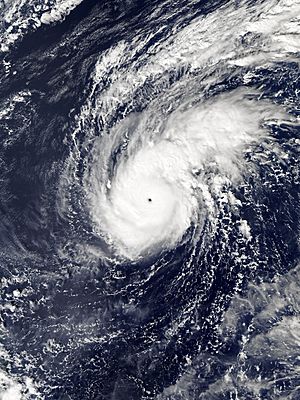
At 4:50 AM on November 1 (Philippine time), PAGASA upgraded Goni to a super typhoon. This was only the second time PAGASA had used the "super typhoon" label since they changed their storm scale. It was also the second time the highest wind warning, Signal #5, was raised in the Philippines.
At 4:50 AM on November 1 (Philippine time), Goni hit land in Bato, Catanduanes, Philippines. It was at its strongest point, as a Category 5 super typhoon. Both the JMA and PAGASA reported 10-minute sustained winds of about 220 km/h (135 mph). The JTWC estimated 1-minute sustained winds of 315 km/h (195 mph). Based on 1-minute sustained winds, Goni became the strongest tropical cyclone ever recorded to make landfall anywhere in the world.
Goni made more landfalls in Tiwi, Albay and San Narciso, Quezon on November 1. Its fourth and final landfall in the Philippines was in Lobo, Batangas. Moving over land and facing stronger winds made Goni weaken quickly. It then moved over the South China Sea as a weak tropical storm.
Before leaving the PAR, Goni got a little stronger. But bad weather conditions stopped it from growing much more. It left the PAR on November 3.
Getting Ready for the Storm
Philippines Prepares for Goni
The Bicol Regional Disaster Risk Reduction and Management Council stopped ships from sailing on October 29. The Philippine Coast Guard also stopped travel permits for boats going to Polillo Island. On October 30, officials in Quezon province went on "red alert." This meant rescue teams were ready at all times.
At the same time, Camarines Norte began moving 35,000 families (about 159,000 people) from dangerous areas. This included coastal villages in Daet. The National Disaster Risk Reduction and Management Council (NDRRMC) also raised a nationwide red alert.
The Research Institute for Tropical Medicine, a big COVID-19 testing lab, closed temporarily. This was to protect their building and equipment. The Philippine Institute of Volcanology and Seismology warned about possible mudflows (lahars) near Mount Pinatubo, Mayon Volcano, and Taal Volcano.
On October 31, PAGASA raised a Signal #3 tropical cyclone warning for Catanduanes. This signal was also raised for parts of Albay and Camarines Sur. Local governments in Camarines Sur started forced evacuations. They expected 20,000 families to evacuate. By noon, Camarines Norte had moved 6,645 people from 75 villages.
The Department of Social Welfare and Development prepared food packs and other supplies for the Bicol Region. Evacuation centers were also set up in Aurora. In Metro Manila, city mayors prepared for the typhoon. They stopped construction and took down outdoor structures. The Disaster Risk Reduction and Management Office in Manila prepared rescue boats.
By evening, PAGASA raised the first Signal #4 warning of the year for Catanduanes and parts of Camarines Sur and Albay. By the end of the day, almost a million people had evacuated. This was more than the number of people evacuated before Typhoon Haiyan in 2013. The Manila International Airport Authority closed Ninoy Aquino International Airport for 24 hours. Port closures left 1,300 passengers stuck in Bicol and Eastern Visayas. Many evacuation centers were already being used by people affected by the COVID-19 pandemic. This made evacuations harder.
Early on November 1, PAGASA raised Signal #5, the highest warning, for Catanduanes, Albay, and all of Camarines Sur. On the morning Goni hit land, PAGASA raised Signal #4 for Metro Manila. All train lines and bus services were stopped. In total, 480,174 people were moved to safety across 8 regions.
Vietnam's Preparations
The National Center for Hydro-Meteorological Forecasting said the storm would hit Da Nang and Phu Yen provinces on November 5. On November 3, officials stopped about 50,000 fishing boats from sailing. The next day, the Quang Ngai People's Committee Chairman asked people in areas prone to landslides to evacuate. Over 64,500 people and 1,718 vehicles were ready for rescue operations.
Impact of Typhoon Goni
Damage in the Philippines
At 4:50 AM on November 1, Goni hit Catanduanes Island. It brought extremely strong winds to areas near its center. At least 25 people died, 399 were injured, and 6 went missing. About 125 cities and towns lost electricity. Over 1.6 million people in 6 regions were affected.
Around 16,900 hectares of farmland were damaged, affecting 18,000 farmers. About 66,000 metric tons of rice, corn, and other crops were destroyed. The NDRRMC reported that roads, bridges, flood control systems, schools, and government buildings were damaged. The total damage was about ₱8.47 billion (US$175.44 million).
Flights and train services started again a day after the typhoon hit. By November 11, the NDRRMC reported ₱12.9 billion (US$266 million) in damage to buildings and roads. Agricultural damage was ₱5 billion (US$103 million). The total damage was ₱17.9 billion (US$369 million). 31 people were reported dead.
Bicol Region Hit Hard
By 8:00 AM (Philippine time), most of the Bicol Region had no power. Electric poles were knocked down, and power lines were damaged. Two evacuation centers lost their roofs because of the strong winds. In Legazpi, flash floods covered villages. Roads were blocked by debris and mudflows (lahars) from Mayon Volcano. The mudflows buried at least 180 houses, vehicles, and farm animals in Guinobatan, Tabaco, Santo Domingo, and Camalig. The Basud Bridge was also destroyed by the mudflows, making it unusable. The famous Cagsawa Ruins were heavily flooded.
The Civil Aviation Authority of the Philippines reported major damage to Naga Airport and moderate damage to Legazpi Airport. They also lost contact with Virac Airport, the only airport on Catanduanes island.
In Albay, at least 14 people died. One was a 5-year-old child swept away by floodwaters. In Catanduanes, at least 6 people died, and 3 were missing. In Pandan, 222 houses were partly damaged.
Calabarzon Floods
Laguna de Bay overflowed by about 1.8 meters (6 feet) due to the typhoon's rains. Nearly 3,000 families had to evacuate. Floods in Batangas City reached the roofs of houses, trapping at least 300 families. The Batangas Disaster Risk Reduction and Management Council asked for more volunteers to help. The floods went down by 9:00 PM on November 2. 110 people were rescued.
Mimaropa Affected
In Marinduque, three towns had flooding. Santa Cruz had floodwaters over 1.8 meters (6 feet) deep. One person went missing, and another was injured after flash floods hit the province. In Oriental Mindoro, one person died, and another was reported missing.
Vietnam's Struggles
On November 5, Tropical Depression Goni hit land in southern Bình Định. This was the fifth tropical cyclone to hit Vietnam in 30 days. A person in Quảng Ngãi was swept away by floodwaters on November 6. Another sailor went missing after his ship sank. Twenty houses in Quảng Nam Province fell into a river, and a school was damaged. In Bình Định, 22 houses and buildings were destroyed by landslides. About 108 hectares (267 acres) of farmland were damaged. Floods covered 1,074 houses. Roads were damaged by erosion and landslides, including parts of the Ho Chi Minh Highway.
The damage in Bình Định Province from both Goni and another storm, Etau, was about ₫543 billion (US$23.5 million).
After the Storm: Recovery and Aid
Philippines Recovery Efforts
| Rank | Storm | Season | Damage | Ref. | |
|---|---|---|---|---|---|
| PHP | USD | ||||
| 1 | Yolanda (Haiyan) | 2013 | ₱95.5 billion | $2.2 billion | |
| 2 | Odette (Rai) | 2021 | ₱51.8 billion | $1.02 billion | |
| 3 | Pablo (Bopha) | 2012 | ₱43.2 billion | $1.06 billion | |
| 4 | Glenda (Rammasun) | 2014 | ₱38.6 billion | $771 million | |
| 5 | Ompong (Mangkhut) | 2018 | ₱33.9 billion | $627 million | |
| 6 | Pepeng (Parma) | 2009 | ₱27.3 billion | $581 million | |
| 7 | Ulysses (Vamco) | 2020 | ₱20.2 billion | $418 million | |
| 8 | Rolly (Goni) | 2020 | ₱20 billion | $369 million | |
| 9 | Paeng (Nalgae) | 2022 | ₱17.6 billion | $321 million | |
| 10 | Pedring (Nesat) | 2011 | ₱15.6 billion | $356 million | |
On October 31, officials in Cavite declared a state of calamity due to the typhoon. In Catanduanes, 90% of buildings were damaged. About 10,000 houses made of light materials were destroyed. Another 3,000 larger houses were either destroyed or damaged. Communication to the island was difficult because 80% of power poles and communication towers were badly damaged. However, communication was quickly restored on November 2.
Damage to the abaca crop on the island was estimated at ₱400 million. Other crops lost about ₱200 million. The total economic loss from the typhoon was estimated to be $1.0 billion.
News coverage of Goni was less than for past typhoons. This was because the ABS-CBN broadcast network was shut down. This network had local news teams and reached many provinces far from Manila. This made it hard to share information about Goni in remote areas. People expressed their frustration on social media during and after the typhoon.
In the Bicol Region alone, over 96,000 families (about 346,000 people) were in evacuation centers. 390,028 people had to leave their homes. 1,103 passengers were stuck in ports. In Aurora, 9,747 people were displaced. About 226 schools were damaged, along with learning materials and computers. Most of these were in Bicol, but some were in Mimaropa and Calabarzon. In total, 68.6 million people were affected by Typhoon Goni in some way. This included 724,000 children in the hardest-hit areas.
The NDDRMC had already suggested not filling evacuation centers completely. This was to follow social distancing rules and prevent the spread of COVID-19. The Department of Health suggested using modular tents and checking people for symptoms in evacuation centers. Health Secretary Francisco Duque III asked local governments to send safety officers to prevent the disease from spreading. However, many health facilities were damaged, and health workers struggled to reach evacuation centers due to floods. In Manila, which had many COVID-19 outbreaks, Mayor Francisco Domagoso said it was hard to follow health rules strictly in evacuation centers. Because of these problems, Congress started talking again about building special evacuation centers.
On November 2, officials in Camarines Sur declared a state of calamity. Catanduanes did the same on November 4. During the 37th ASEAN Summit on November 12, President Rodrigo Duterte asked other member countries to help fight climate change.
Help from Other Countries
Many countries and organizations sent help to the Philippines:
- United Nations:
- Food and Agriculture Organization: Helped check the damage to crops.
- United Nations Children's Fund (UNICEF): Sent hygiene items, child-friendly tents, and education materials.
- Office for the Coordination of Humanitarian Affairs (OCHA): Asked for US$45.5 million to help 260,000 people for six months.
- International Organization for Migration (IOM): Sent teams to check the needs of displaced people. They also sent personal protective equipment (like face masks and hand sanitizer) and tents to help with the COVID-19 pandemic.
 United States: Helped deliver relief goods and emergency shelter supplies. They donated US$200,000 through their Agency for International Development.
United States: Helped deliver relief goods and emergency shelter supplies. They donated US$200,000 through their Agency for International Development. Australia: Provided emergency shelter kits through the Philippine Red Cross.
Australia: Provided emergency shelter kits through the Philippine Red Cross. United Arab Emirates: Donated Dh35 million (US$9.52 million) as urgent humanitarian aid.
United Arab Emirates: Donated Dh35 million (US$9.52 million) as urgent humanitarian aid. United Kingdom: Donated £1 million (US$1.30 million) to both the Philippines and Vietnam. This money was given through the International Federation of Red Cross and Red Crescent Societies.
United Kingdom: Donated £1 million (US$1.30 million) to both the Philippines and Vietnam. This money was given through the International Federation of Red Cross and Red Crescent Societies. Singapore: The Singapore Red Cross gave SG$50,000 (US$36,700) to the Philippine Red Cross.
Singapore: The Singapore Red Cross gave SG$50,000 (US$36,700) to the Philippine Red Cross. South Korea: Donated US$200,000 to the Philippine Red Cross.
South Korea: Donated US$200,000 to the Philippine Red Cross.
Name Retirement
Because of the huge damage in the Philippines, PAGASA announced that the name Rolly will no longer be used for typhoons. It has been removed from the list of typhoon names. In January 2021, PAGASA chose Romina as its replacement for the 2024 season.
After the typhoon season, the Typhoon Committee also decided to remove the name Goni from the international naming lists. In spring 2022, the name was replaced with Gaenari.
More to Explore
 In Spanish: Tifón Goni para niños
In Spanish: Tifón Goni para niños
- Weather of 2020
- Tropical cyclones in 2020
- List of violent typhoons
- List of super typhoons
- Typhoon Angela (1995) – A typhoon that moved in a similar way to Goni.
- Typhoon Haiyan (2013)
- Typhoon Molave (2020) – Another strong typhoon that hit the same areas a few days before Goni.
- Typhoon Vamco (2020) – Another powerful typhoon that affected the same areas shortly after Goni.
- Typhoon Noru (2022) - A very destructive Category 5 typhoon that hit the same areas two years later and also got stronger very quickly. It also moved similarly to Goni.


